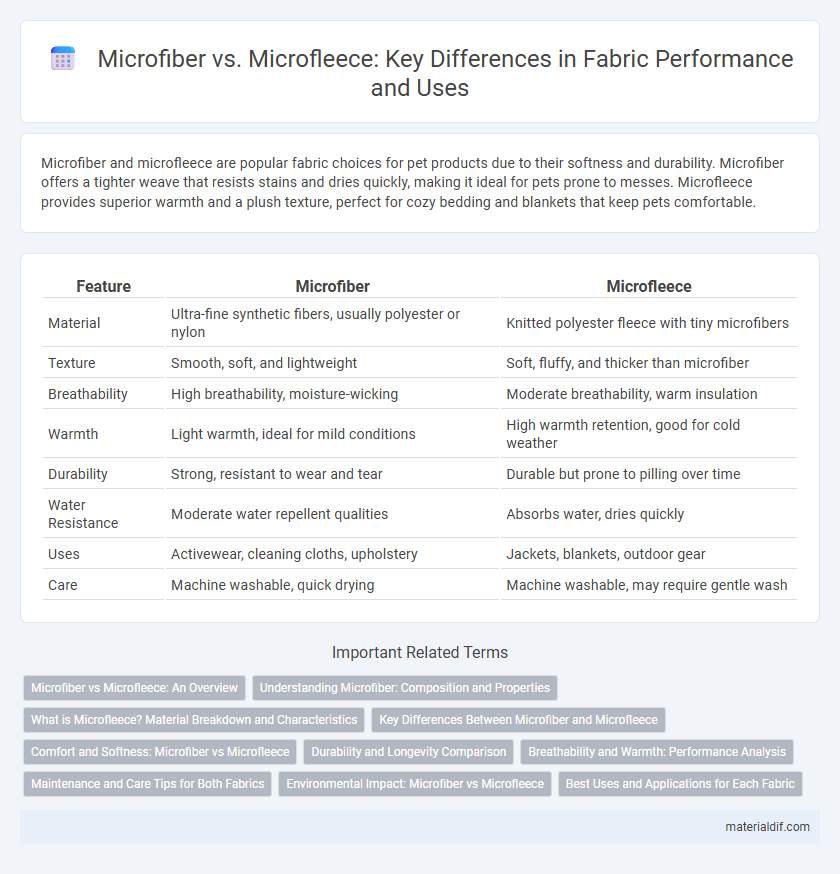Microfiber and microfleece are popular fabric choices for pet products due to their softness and durability. Microfiber offers a tighter weave that resists stains and dries quickly, making it ideal for pets prone to messes. Microfleece provides superior warmth and a plush texture, perfect for cozy bedding and blankets that keep pets comfortable.
Table of Comparison
| Feature | Microfiber | Microfleece |
|---|---|---|
| Material | Ultra-fine synthetic fibers, usually polyester or nylon | Knitted polyester fleece with tiny microfibers |
| Texture | Smooth, soft, and lightweight | Soft, fluffy, and thicker than microfiber |
| Breathability | High breathability, moisture-wicking | Moderate breathability, warm insulation |
| Warmth | Light warmth, ideal for mild conditions | High warmth retention, good for cold weather |
| Durability | Strong, resistant to wear and tear | Durable but prone to pilling over time |
| Water Resistance | Moderate water repellent qualities | Absorbs water, dries quickly |
| Uses | Activewear, cleaning cloths, upholstery | Jackets, blankets, outdoor gear |
| Care | Machine washable, quick drying | Machine washable, may require gentle wash |
Microfiber vs Microfleece: An Overview
Microfiber and microfleece are both synthetic fabrics known for their lightweight and soft texture, but microfiber consists of ultra-fine polyester or nylon fibers woven tightly to create a smooth, durable surface, while microfleece is a type of knitted polyester fabric designed to mimic natural fleece's insulating properties. Microfiber excels in moisture-wicking and stain resistance, making it ideal for activewear and cleaning cloths, whereas microfleece provides excellent warmth and breathability, often used in jackets and blankets. Understanding the distinct fiber structure and functional benefits helps choose the right fabric for specific textile applications.
Understanding Microfiber: Composition and Properties
Microfiber is a synthetic fiber finer than one denier, usually made from polyester or nylon, offering high durability and resistance to moisture and stains. Its ultra-fine strands create a dense weave that enhances softness, breathability, and quick-drying properties. These characteristics make microfiber an excellent choice for lightweight, wrinkle-resistant fabrics used in activewear, upholstery, and cleaning cloths.
What is Microfleece? Material Breakdown and Characteristics
Microfleece is a lightweight, synthetic fabric made from polyester fibers, designed to mimic the insulating properties of wool while offering superior moisture-wicking and quick-drying capabilities. Its ultra-fine fibers create a soft, plush texture with excellent breathability and warmth, making it ideal for cold-weather clothing and activewear. Compared to traditional fleece, microfleece is thinner yet highly durable, resistant to pilling, and maintains heat retention even when damp.
Key Differences Between Microfiber and Microfleece
Microfiber consists of ultra-fine synthetic fibers designed for durability and water resistance, making it ideal for cleaning and outerwear applications. Microfleece, made from knitted polyester fibers, offers superior warmth and breathability, commonly used in cozy, lightweight apparel. The key differences lie in microfiber's smooth texture and water-repellent properties versus microfleece's soft, insulating, and moisture-wicking characteristics.
Comfort and Softness: Microfiber vs Microfleece
Microfiber fabric offers exceptional softness and a smooth texture, making it ideal for sensitive skin and lightweight comfort. Microfleece, made from polyester, provides a plush, cozy feel with superior warmth retention and breathability. Both fabrics excel in comfort, but microfiber is better suited for moisture-wicking and everyday wear, while microfleece is favored for insulating layers and colder climates.
Durability and Longevity Comparison
Microfiber fabric, made from ultra-fine synthetic fibers, offers exceptional durability due to its tightly woven construction that resists wear and tear over time. Microfleece, composed of polyester fleece with a brushed texture, provides warmth and softness but tends to be less durable, as its plush surface is more susceptible to pilling and abrasion. When evaluating longevity, microfiber outperforms microfleece in retaining structural integrity and appearance after repeated use and washing.
Breathability and Warmth: Performance Analysis
Microfiber fabric offers superior breathability due to its fine synthetic fibers, allowing better moisture wicking and ventilation than microfleece. In contrast, microfleece provides enhanced warmth with its thicker, plush pile that traps heat effectively, making it ideal for colder environments. Performance analysis reveals microfiber excels in active wear for temperature regulation, while microfleece is preferred for insulating layers in cold conditions.
Maintenance and Care Tips for Both Fabrics
Microfiber requires gentle washing in cold water with mild detergent to maintain its softness and water-repellent properties, avoiding fabric softeners that can clog fibers. Microfleece benefits from washing in warm water on a gentle cycle, with tumble drying on low heat or air drying to preserve its insulating air pockets and prevent pilling. Both fabrics should be kept away from bleach and high heat to extend their lifespan and retain their texture and functionality.
Environmental Impact: Microfiber vs Microfleece
Microfiber production relies heavily on synthetic polymers like polyester and nylon, contributing significantly to plastic pollution through microplastic shedding during washing. Microfleece, typically made from recycled polyester, offers a slightly reduced environmental footprint by utilizing post-consumer plastic bottles, though it still releases microplastics into water systems. Both fabrics pose challenges for sustainability, but microfleece's recycled content provides a marginal advantage in reducing virgin plastic use.
Best Uses and Applications for Each Fabric
Microfiber excels in moisture-wicking and quick-drying properties, making it ideal for activewear, bedding, and cleaning cloths where breathability and absorbency are crucial. Microfleece provides superior insulation and softness, perfect for cold-weather apparel, blankets, and outdoor gear requiring warmth without bulk. Selecting microfiber suits high-performance, moisture-management needs, while microfleece is best for cozy, thermal comfort in cooler environments.
Microfiber vs Microfleece Infographic

 materialdif.com
materialdif.com